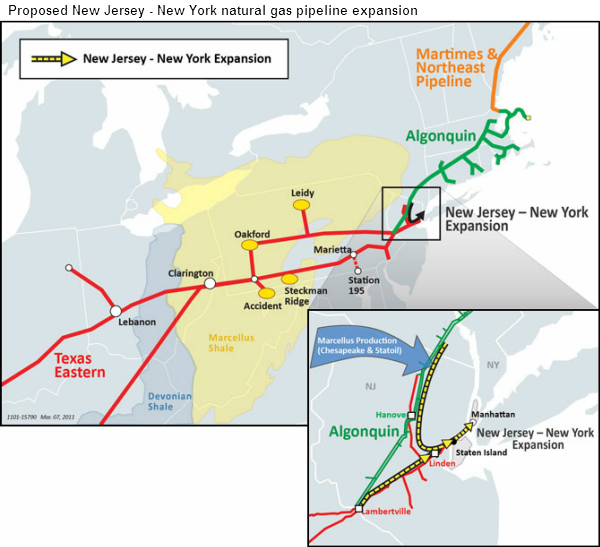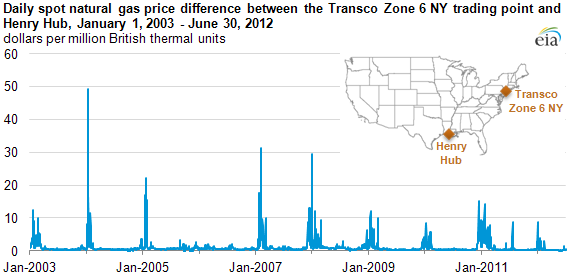From Reuters, June 29:
Spectra to begin work on NJ-NY natgas line "in weeks"
From Spectra via the EIA:
Spectra Energy has received final approval to build a $1.2 billion natural gas pipeline that will connect New York City to the New Jersey network and producing regions across the country, it said on Friday.
The Houston-based company will begin construction on the 20-mile (32-km) extension "in the coming weeks", it said in a statement, after receiving the go-ahead from the Federal Energy Regulatory Commission.
The 800-million-cubic-feet-per-day pipeline, which will be the first in 40 years to connect New York City to the wider U.S. gas grid, is expected to be completed in the fourth quarter of 2013, Spectra said.
It will tie into Spectra's Texas Eastern Transmission and Algonquin pipelines, giving New York new access to producing regions in Pennsylvania, the Rockies and the southern Gulf region.
The line has received stiff opposition from locals concerned about the effect that increased natural gas drilling has on the environment. But it fits with New York City's plan to reduce harmful emissions by burning more natural gas than dirtier oil-based fuels....MORE
New pipeline project could lower natural gas transportation costs to New York City

Source: Spectra Energy Corp.
Note: In the map, the white squares are compressor stations, the yellow circles are natural gas storage fields, and the white circles indicate interconnections with pipelines.
Note: In the map, the white squares are compressor stations, the yellow circles are natural gas storage fields, and the white circles indicate interconnections with pipelines.
Future natural gas transportation costs to New York City could be reduced with the expansion of the existing Texas Eastern Transmission pipeline from Linden, New Jersey to Manhattan, New York (see map above). On May 22, 2012, the Federal Energy Regulatory Commission (FERC)—the main jurisdictional authority over the construction of interstate natural gas pipelines in the United States—approved an 800,000 million British thermal unit (MMBtu) per day, or 800,000 dekatherms per day, expansion of the pipeline.
This project is slated to begin service in November 2013 and represents one of the biggest transportation service expansions in the Northeast during the past two decades. The project could have the following effects on the New York City market: reduce reliance on oil-fired generators, enhance the reliability of natural gas supplies, and lower transportation costs—especially in the winter. Spectra Energy secured firm transportation agreements for this expansion with these customers: Consolidated Edison (170,000 MMBtu per day); Chesapeake Energy Marketing, Inc. (425,250 MMBtu per day); and Statoil Natural Gas LLC (204,750 MMBtu per day).
The spread between the price of natural gas at a supply location like the Henry Hub in Erath, Louisiana and a delivery market such as New York City can be quite high on congested parts of the natural gas grid, especially in the winter. For example, on a peak winter day in January 2004, the spread peaked at about $50/MMBtu—meaning the Transco Zone 6 NY price was more than nine times the Henry Hub price—as pipelines into the New York market area were highly constrained. As shown in the graph below, spreads in the $5/MMBtu-to-$15/MMBtu range have occurred frequently during December and January.

Source: U.S. Energy Information Administration, based on Bloomberg.
Note: This chart reflects the differences for physical natural gas reported at the Henry Hub and Transco Zone 6 NY trading points.
Note: This chart reflects the differences for physical natural gas reported at the Henry Hub and Transco Zone 6 NY trading points.
The New York City market reflects one of three major constrained areas on the natural gas grid in the Northeast United States....MORE